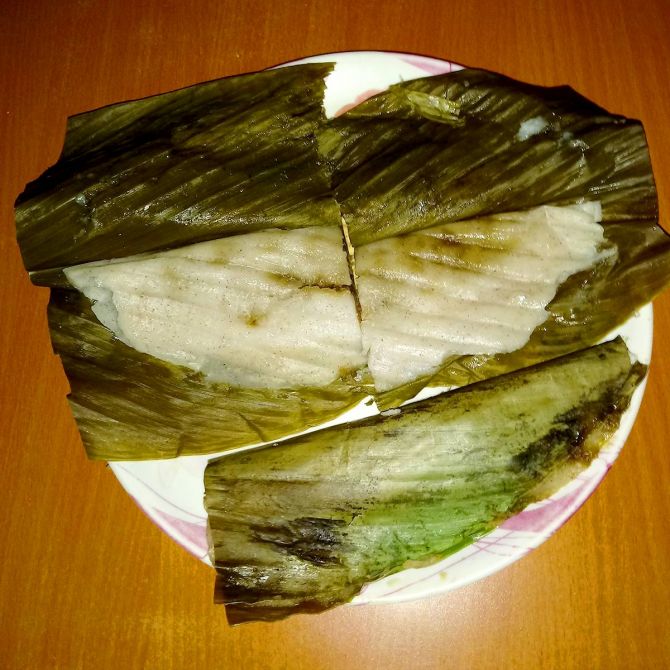No Indian festival is complete, usually, without at least one dish that includes coconut, jaggery or haldi in some form.
In Karnataka, Haldi Paan Patholi or Arisina Ele Gatti or Manjal Irre Da Gatti -- gatti which is made with rice and turmeric leaves -- is a staple for almost all occasions.
Gatti is a sweet preparation concocted from rice flour, coconut and jaggery and is steamed, traditionally, in haldi paan or turmeric leaves. You can also use plantain or banana leaves or badam or almond leaves.
Gatti or Haldi Paan Patholi, as it is popularly known in parts of Karnataka, Maharashtra and Goa, is cooked for Nag Panchami, Ganeshotsav, Diwali and Dusshera.
A version of this dish, called Ela Ada, is also prepared in certain parts of Kerala during Onam -- the turmeric leaves are replaced with plantain leaves.
If there are elders in your family who are diabetic or health-conscious, you can prepare this dish without jaggery.
If you are making it with red rice, be warned that it can be a slightly more challenging process because red rice is tough to grind in a mixer, especially if you are using very little water. If you are using regular par-boiled white rice, it is much easier to put together.
In certain parts of Kerala and Karnataka, gatti or ada is also prepared with pineapple or jackfruit batter. Please have a look at this recipe of Pelakkai Gatti made using jackfruit batter.
Kumudini grew up in Shirva, a village in Udupi, Karnataka. The 66-year-old homemaker divides time between her ancestral home in Udupi and Mumbai to be there for her three children and two grandchildren and to celebrate important festivals with them, especially Diwali and Dasshera.
When friends and guests come home, she loves pampering them with different versions of gatti, goli bajje, pathrade (colocasia-based steamed cake), neer dosas, kori rottis and Mutton Sukka, which are a few special dishes of her vast repertoire.

Haldi Paan Patholi
Servings: 8-10
Ingredients
- 2 cups red rice/par boiled rice/idli rice, soaked in water for 6 to 8 hours
- 1½ cups grated fresh coconut
- 1 cup grated or powdered jaggery
- 1 tsp green elaichi or cardamom powder
- 8-10 haldi paan or turmeric leaves, larger size if possible
- 4-5 tsp ghee
- Salt to taste, around 2 tsp
Method
- Wash and grind the rice using as little water as possible and turn out into a bowl.
The batter needs to be thick and firm and not of flowing consistency.
If you happen to have added extra water while grinding, make the batter thicker by adding add a few tsp of rice flour.
Add the salt.
Stir and keep aside. - In a kadhai, heat 2 tsp of the ghee over medium heat.
Add the grated jaggery and the grated coconut and mix.
Don't add water.
Add a pinch more of salt, if preferred.
Keep stirring as the jaggery melts.
Once the water given off by the coconut dries out, add the cardamom powder and mix.
Take off heat and cool. - Wash the turmeric leaves and dry using a kitchen towel.
- Grease a turmeric leaf with a bit of the remaining ghee and place a ball of 1½ inch diameter of the rice batter on it.
If your turmeric leaves are smaller and only about the size of your palm, let the ball of rice batter be 1 inch in diameter.
Spread it out well using your fingers or the back of a flat vaati/katori or small steel bowl.
Remember your gatti will taste better if the rice batter layer is smooth and thin.
Add about 1½ tbsp of the prepared stuffing and spread it evenly.
Slowly fold the leaf lengthwise, carefully pressing the edges to secure the stuffing.
Repeat the process for the remaining leaves and batter.
Keep aside. - Heat 3-4 cups water in an idli steamer.
Place a perforated plate inside and arrange the gattis neatly, one after the other, allowing ample space for them to cook evenly.
If your steamer is small, cook 3-4 gattis per batch.
Cover and cook for 10-12 minutes over slow to medium heat.
Take off heat and allow it to cool for 10 minutes before taking off the lid.
To serve, gently remove the leaf and pour a tsp of melted ghee on top of the gatti.
The thinner you are able to roll each gatti, the more servings you will get.
Kumudini's Note: Gatti is best served hot and for breakfast or as a dessert along with your main meal.
If you are not using jaggery, have the gatti like a steamed pancake with any curry or chutney of your choice.

When in Mumbai, Kumudini lives in Thane.












 © 2025
© 2025